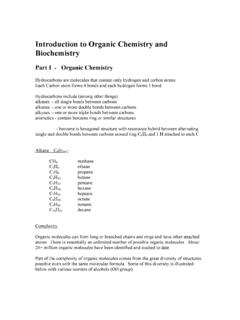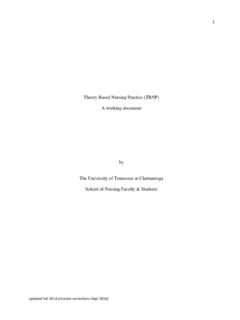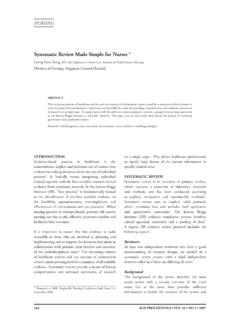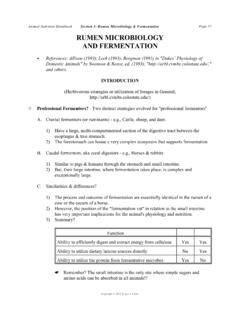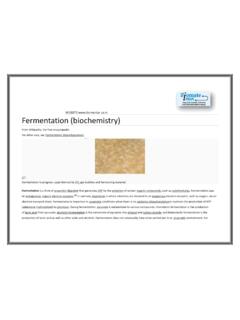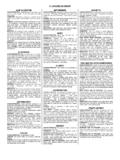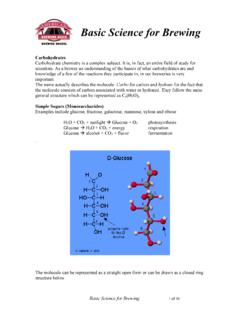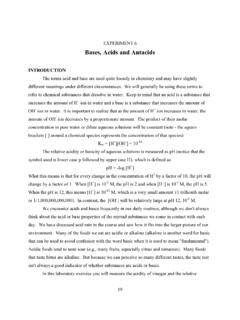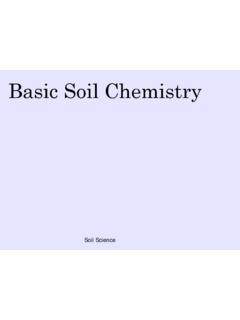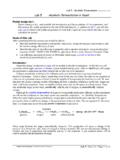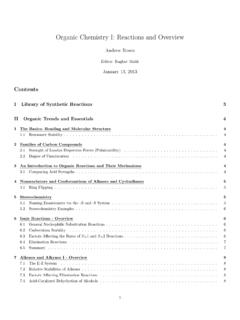Transcription of Introduction to Organic Chemistry and Biochemistry
1 Introduction to Organic Chemistry and Biochemistry Part I - Organic Chemistry Hydrocarbons are molecules that contain only hydrogen and carbon atoms Each Carbon atom forms 4 bonds and each hydrogen forms 1 bond Hydrocarbons include (among other things) alkanes - all single bonds between carbons alkenes - one or more double bonds between carbons alkynes - one or more triple bonds between carbons aromatics - contain benzene ring or similar structures - benzene is hexagonal structure with resonance hybrid between alternating single and double bonds between carbons around ring C6H6 and 1 H attached to each C Alkane CnH2n+2 CH4 methane C2H6 ethane C3H8 propane C4H10 butane C5H12 pentane C6H14 hexane C7H16 heptane C8H18 octane C9H20 nonane C10H22 decane Complexity Organic molecules can form long or branched chains and rings and have other attached atoms.
2 There is essentially an unlimited number of possible Organic molecules. About 20+ million Organic molecules have been identified and studied to date. Part of the complexity of Organic molecules comes from the great diversity of structures possible even with the same molecular formula. Some of this diversity is illustrated below with various isomers of alcohols (OH group). Compounds that have the same molecular formula but different structural formulas are defined as isomers. Each isomer will have different physical properties of boiling point, melting point, solubility, density, and unique chemical properties. Sources of Hydrocarbons Oil, coal, natural gas- from decomposition of animal/ vegetable matter Plants build up larger molecules 6 CO2 + 6 H2O C6H12O6 + 6 O2 Refining Petroleum Boiling Range Carbon Atoms Fraction Use -164 20 1 4 gas fuel, heating 20 90 5 7 petroleum ether solvent 35 220 5 12 gasoline fuel 200 315 12 16 kerosene heating jet fuel 250 375 15 18 fuel oil Diesel Fuel, heating 350 16 20 oil, grease lubrication Separation- Fractionating Tower Conversion Cracking oil to gasoline ,0,w Functional Groups When other atoms such as oxygen or nitrogen are included in an Organic molecule the added atoms can change the physical and chemical properties dramatically and these groups of atoms are called functional groups.
3 Name Functional Group General Formula Alcohol -OH R-OH Ether -O- R-O-R Aldehyde -CH=O R-CH=O Ketone -C=O R-C=O R Carboxylic acid HO-C=O OH-C-O R Ester O=C-O- O=C-O-R R Amine -N- R-N-R , H-N-R, H-N-R R H R Amide O=C-N- O=C-NH2 R R and R represent any hydrocarbon group that completes the molecular structure Examples of Organic Molecules and Functional Groups Type Structure Name Use/ Effect Alcohol CH3-OH Methanol Poison, blindness,death (wood alcohol) CH2-CH2-OH Ehtanol Ingredient in beer, wine (grian alcohol) Cirrhous (scarring) of liver Byproduct of fermentation Ethylene glycol Antifreeze in radiator (dihydroxy alc.)
4 Glycerol Lubricant (Glycerine) (Trihydroxy alc.) Phenol Destructive to animal tissue Carboxylic Acid Pure glacial Destroy animal tissue, vinegar is a dilute solution of acetic acid Formic acid Causes pain from ant bite Acetylsalicylic aspirin acid (ASA) Salicylic acid Ester Ethyl acetate Remover for fingernail polish N-pentyl acetate Aroma of bananas N-octyl acetate Aroma of oranges Ketone Acetone Solvent for plastics Muscone musk oil, cologne, perfurme Aldehyde Formaldehyde Embalming fluid, preservative Ether Ethyl ether general anesthetic Amine Scatol Smell of fecal matter (3-methylindole) Amide 4- Acetamido Active ingredient in tylenol phenol (Acetominophen) Isomers - same formula different structure Structural Isomers Differ in sequence of atoms C4H10 Stereoisomers same sequence but different in spatial arrangement Geometric isomers double bond Optical isomers due to chirality of carbon , chiral carbon has 4 different groups on carbon Lactic acid builds up in muscle tissue and causes soreness (+) Lactic acid (-) Lactic acid Levorotatory Dextrorotatory Part II Biochemistry Introduction Biochemistry is the Chemistry of living things.
5 To understand and control or modify (for disease prevention or other purposes) chemical reactions of living organisms, we must understand life on the molecular level. Since living things are extremely complicated then the chemical reactions and molecules must be very complex, however we can get an overview by understanding 4 types of biomolecules. We will greatly simpifly all these details by giving some general structural features of biomolecules and their primary role in living systems. Biomolecules (basic types and their role in cells) 1) Lipids cell membranes and energy storage in fats 2) Carbohydrates- energy source and cell surfaces 3) Proteins molecules that do work of cell (carry out many reactions) 4) Nucleic Acids molecules that contains instructions on how to make proteins (genetic information) 1) Lipids Lipids are water insoluble substances.
6 (a) Lipids provide structure of cell membranes (b) Lipids provide for storage of energy for metabolism in fats (c) Lipids or derivatives of lipids are found in hormones and some vitamins. Some examples of a few different types of lipids are shown below. The picture below shows that lipid molecules found in cell membranes contain a short polar end and a longer nonpolar portion. The polar end is sometimes called the head and the longer nonpolar portion the tail. In the membrane shown below there is a double layer of lipids with the nonpolar tails toward the middle and the polar heads on the inner and outer surface of the membrane. For much more detail about lipids you can see the website below: #role 2) Carbohydrates Carbohydrates are sugars and substances that hydrolyze to yield sugars.
7 (Hydrolysis is the breaking of a bond by adding a water molecule (H+ to one side and OH to the other) They have formulas like Cx(H2O)y where x, y may be from 3 up to thousands. They are also referred to as saccharides. monosaccharides do not undergo hydrolysis (examples: glucose, fructose) disaccharides hydrolyze to two monosaccharides (examples: sucrose, lactose) polysaccharides hydrolyze to many monosaccharides (examples: starch, cellulose) Monosaccharide example Glucose Glucose is a sugar found widely in nature. Starch and cellulose are both made of hundreds of linked glucose molecules. Glucose is the most common Organic molecule in the world because it is found in all plants. Other carbohydrates such as starch are converted in your body to glucose prior to breakdown in your body for energy.)
8 Ultimately glucose undergoes oxidation to CO2 and H2O. The formula of glucose is C6H12O6 and it can exist as chain or ring form as shown below. Cyclic form is dominate (preferred). Glucose contains 4 chiral carbons so the open chain form can have 16 possible structures depending on the orientation of each of the OH functional groups 24 = 16. Glucose is just one of these possibilities but it is the most common one in nature. IV fluids contain glucose and some salts. Table sugar is a disaccharide that is a combination of two sugar molecules (glucose and fructose). Polysaccharides are composed of many sugar molecules (monosaccharide units) linked together. Starch is made of 200 to 3000 glucose units. Glucose is joined with all molecules in branched chain pattern with all the glucose rings with the same orientation.
9 Cellulose is made of 2000 to 4000 glucose units. Glucose is attached end to end to form long filament molecules. Each glucose ring has the opposite orientation of the one before it. Unlike cows, horses, sheep, etc., humans cannot digest cellulose because we lack the enzymes necessary for this chemical reaction. The enzyme (a protein molecule) must have a certain shape that fits the molecule to undergo reaction and because of the different orientation of the glucoses starch and celluose require different enzymes. If we did not lack these enzymes, we could go into our front yards or into parks and eat grass whenever we got hungry. Sample starch molecules are shown below that contain many glucoses linked together. $FILE/Starch% 3) Proteins Introduction Protein molecules are in all living tissues of plant and animals Proteins contain C, H, N, O, and S atoms May contain other atoms as well Proteins have many roles in our bodies and in all living things.
10 Covering in hair, skin, and nails Chemical reactions enzymes that catalyze chemical reactions Transport - Hemoglobin carries O2 in blood Motion muscles are made of proteins Coordinate chemical activities insulin is used in glucose metabolism Proteins are built up from repeated units of amino acids and may have molecular weights of 6,000 to 3,000,000 amu (or g/mol) Amino acids 20 different amino acids are found in nature - all amino acids have amino group, carboxyl group, H atom and one other group (side chain) attached to carbon atom. Only the side group various among different amino acids. So an amino acid is defined by its side group. Ends may be charged or neutral depending on pH of solution. :&tbnh=140&tbnw=106&hl=en&start=1&prev=/ images%3Fq%3 Damino%2 Bacids%26svnum%3D10%26hl%3 Den%26lr%3D%26ie%3 DUTF-8%26oe%3 DISO-8859-1%26sa%3DG Polypeptides Several to many amino acids are joined together in a chain is called a polypeptide.
